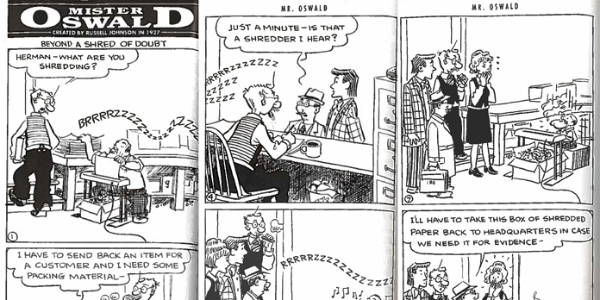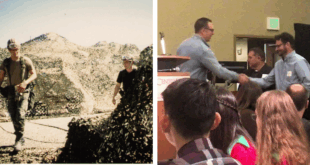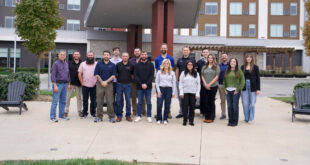
When it comes to pop culture icons, he may not be mainstream, but Mister Oswald has garnered celebrity status and a loyal following in the hardware industry. He first appeared in the comic strip bearing his same name in October 1927 and would delight readers of Hardware Retail magazine for over eight decades.
Mister Oswald was born from the creative mind of Russell Johnson, an artist and independent retailer. At the start of World War I in 1917, Johnson enlisted with the U.S. Navy and throughout his time kept his love of cartooning alive by drawing cartoons for Afloat and Ashore, a Naval paper published in Charleston.

After the war, Johnson returned to his job at Montgomery Ward in Chicago and took night classes at the Chicago Academy of Fine Arts, which had a cartoon arts program. In 1921, Johnson moved back to his hometown of Gibson City, Illinois, where he worked in his father’s hardware store. He drew advertising cartoons for the store’s window displays and created cartoons for one of the local newspapers. An editor for Hardware Retailer saw Johnson’s work in the newspaper and reached out to Johnson. In 1925, Johnson began a six-decade stint with the magazine and brought Mister Oswald to life.
After retiring from retail in 1963, Johnson continued working on the Mister Oswald comic for two more decades. At the age of 95, he officially retired, passing the reins to illustrator Larry Day, who had been assisting Johnson with the comic since the early 1980s. Mister Oswald last appeared in the magazine in 2008. Johnson worked on his strip continuously for 62 years, a record for a comic strip done by its original creator.
Learning From the Best
 Illustrator Larry Day reflects on his time penning the Mister Oswald comic strip after taking over from Russell Johnson in the 1980s.
Illustrator Larry Day reflects on his time penning the Mister Oswald comic strip after taking over from Russell Johnson in the 1980s.
Hardware Retailing (HR): How did you get connected with Russel Johnson and start creating Mister Oswald?
Larry Day (LD): I was an instant fan after seeing a copy of “Forty Years with Mr. Oswald.” My father brought home a signed copy from the local hardware store where Russell was signing copies. He wanted me to meet Russell, but I was a shy 18-year-old. My younger brother tagged along with my father and had Russell sign me a copy anyway. When I opened the book, I was mesmerized. I devoured it. That someone with that level of skill who lived in our small rural farm town with that kind of drawing and draughtsmanship floored me. Mr. Oswald was on par with the best cartoonists in the world where the ideas, pacing and characters were rich, funny, delightful and engaging, not to mention the history lessons and the familiarity of our small town.
I dropped my shyness and decided to meet him. Russell lived on Ninth Street, right across from the elementary school where I attended kindergarten through fourth grade. He lived in a cute red brick two-story bungalow with a large porch and a dormer out the front. I never thought anything about it or who lived there the years going to school. It was just another house on the block. Little did I know a genius was hard at work inside.
The year was 1974, a year before heading to college where I would be studying commercial art. I decided to overpower my shyness and finally meet this local cartoonist. Russell was 81 and a bit hard of hearing. It took a while to answer my increasingly loud knocking. I was ready to leave when the door opened. I introduced myself and he said, “Come in, make yourself homely.” I instantly felt welcome.
That’s how I met Russell Johnson, the genius.
I don’t remember the actual year I started drawing Mr. Oswald. I think it was a few years after Russell sold the copyright to Hardware Retailing. After having the longest running comic strip ever, he decided to call it quits. A nationwide search was put out for his replacement. Russell shared a few of the submissions when he turned to me and said, “Why don’t you send a sample?”
By then I had been over to his house many times, getting to know him well. I saw how he worked out his ideas and the pacing of each character with thumbnail sketches and final drawings and how he inked and lettered each strip. I admired that these were all his own creations, characters from his own Johnson’s Hardware store on Sangamon Avenue.
HR: What did it mean to you to be a part of such a storied comic strip?
LD: It meant the world to be a part of Russell’s creation. Each of his characters were engaging and full of their own unique psychological makeup and drama. The cast was large and all local folk. It was a rarity, and I knew it. I was a part of that and also a part of an instant audience, a large community of loyal hardware dealers across the country.
Russell’s shoes were not easy to fill. I felt I came close to Russell’s level on a couple of occasions, but it was always Russell’s inspiration in the back of my mind that kept me going. When anyone asked how he came up with his ideas he would always reply “cocaine.” He never did cocaine, and neither have I, but his work had an intoxicating magic to it. Russell was a natural. He was sharply in tune with the world around him.
HR: Did you have a favorite Mister Oswald character or comic strip you worked on?
LD: My favorite characters were Mister Oswald and Herman Hammers, his feisty and determined employee. Some of the side characters were endearing to me like Hotair, the hardware wholesaler who made periodic visits. I loved creating dialogue between the two.
The Legend Lives On
 A fan of Mister Oswald for over 30 years, comic book fan Rob Stolzer created a website dedicated to the comic strip icon after finding a copy of “Forty Years with Mister Oswald” in a book store. Stolzer shared with Hardware Retailing his appreciation for Russell Johnson and Mister Oswald.
A fan of Mister Oswald for over 30 years, comic book fan Rob Stolzer created a website dedicated to the comic strip icon after finding a copy of “Forty Years with Mister Oswald” in a book store. Stolzer shared with Hardware Retailing his appreciation for Russell Johnson and Mister Oswald.
Hardware Retailing (HR): When did you first become interested in Russell Johnson and Mister Oswald?
Rob Stolzer (RS): I was antiquing in Galena, Illinois, in 1993 when I ran across a used bookstore. Coming from a family that loved books, I always visited used bookstores when traveling, especially during those pre-and-newish internet days. Being a collector of comic strip art and books, I made sure to visit the humor section of bookstores. You never know what you might discover. On this day in this small Illinois town, I ran across a slightly worn hardcover book with gray boards: Forty Years with Mister Oswald. I had been studying old comic strips for well over a decade at the time, but never heard of either the comic strip or the cartoonist, Russ Johnson.
Leafing through the book, I was smitten with the style. Great cartooning from days gone by. I’m also a sucker for cartoons that reflect social history, and I loved that the strip revolved around a hardware store. But I was not smitten by the price, which is still marked in pencil on the upper right corner of the front-end page: $20. I looked through the book again, considered the price, and grudgingly put it back on the shelf. I left the store and made it nearly one block before I turned around, went back to the bookstore and purchased the book. That was my introduction to Russ’s work.
HR: When did you launch the Mister Oswald website? What was the motivation for starting that?
RS: Not long after I purchased the book back in 1993, I began searching for information about Russ and his comic strip. There had been a couple of published interviews done years earlier, but nothing recent. I decided to try and contact Russ. Luckily, a friend of mine had his address, so I wrote him an old-fashioned letter. In July 1995, I was able to conduct Russ’s final interview, as he passed away two months later. That interview ran in the pages of Hogan’s Alley magazine, a publication devoted to the cartoon and narrative arts.
I had already been collecting original comic and comic strip art for over a decade at this point, and Russ kindly gifted me two original Mister Oswald pages. I began to gather other material about the feature, including old tearsheets. As the internet grew and I learned more about building websites, I decided that I would like to do something devoted to Russ and his creation. So I secured the domain name and contacted the folks at Hardware Retailing magazine to seek permission. This took a few years of touching back every so often, but in 2021 I was given the go-ahead to create the site. I was later a guest on Dan Tratensek’s “Taking Care of Business” podcast to talk about Russ and Mister Oswald.
HR: Why do you think Mister Oswald has achieved such a loyal following?
RS: There are a few reasons. First and foremost, Russ was a terrific cartoonist! He studied with professional cartoonists like Billy DeBeck (creator of Barney Google) in Chicago in the 1920s, and he really honed his craft as time went on. Russ drew wonderful figures and the details he put into the store are amazing! How many nuts and bolts did he draw over the decades?
Russ created wonderfully believable and flawed characters that readers could relate to, whether they were or are in the hardware business or not. Part of that character extends to the spaces he created. I love the family-owned hardware stores that are sadly disappearing, and Mister Oswald’s store is a perfect example of one of stores where you could go in and ask specific questions about a job or purchase a single bolt.
Mister Oswald is a mirror of the time it was created in, and I believe that readers respond to that reflection of time and place. During World War II, Mister Oswald struggled with not only keeping staff in the store, but materials as well. During the post-war boom, Mister Oswald faced different issues, the same as other store owners. Russ’s strip is a time capsule. And because he drew and wrote the strip so well, that time capsule is brought to life over and over again.
Independent retailer and owner of Pedrotti Ace Hardware, Gene Pedrotti, shares his love and appreciation for Mister Oswald and the positive impact the comic made in his life and career. Read his column here.
 Hardware Retailing The Industry's Source for Insights and Information
Hardware Retailing The Industry's Source for Insights and Information







